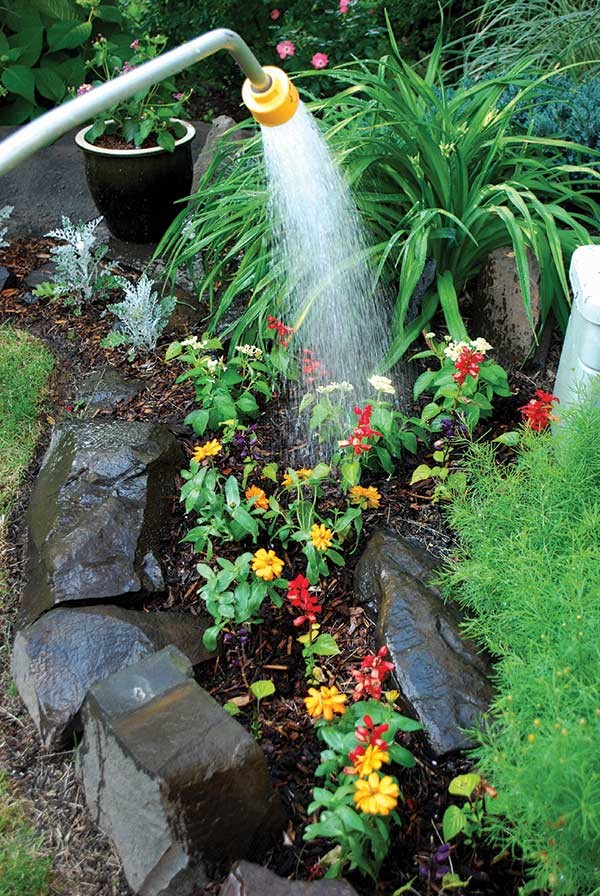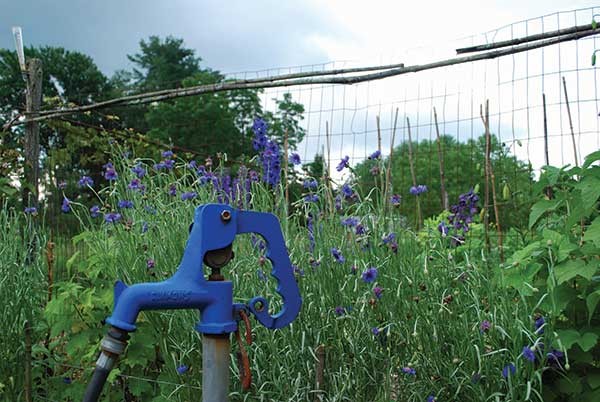Sometimes Hollywood depictions of gardeners are quite comical. In The Next Best Thing, an otherwise forgettable Madonna movie, ingrained in my memory is Rupert Everett, playing a gardener in arid California, waving a watering nozzle in the remote vicinity of some shrubs, barely misting them—in other words, watering the air.
If I was hired as a consultant for horticultural accuracy in a movie (nice fantasy), I'd have our heroine depicted filling an irrigation bag, the kind that's designed to hold 20 gallons of water and slowly release it over the root system of a newly planted tree. Now that would be sexy, and educational!
The practice of watering plants seems like it should be pretty simple, but there are some simple techniques that make a big difference. From my own trials and errors, I have some thoughts to share along with those of my colleague Allyson Levy, who with her husband Scott Serrano owns Hortus Conclusus in Stone Ridge. They are garden designers, horticulturists, and educators who regularly open their extensive gardens to the public.
Newly planted stuff needs more localized water. You will frequently encounter the guideline that plants need one to two inches of water provided weekly by some combination of rainfall and hand watering. That is great for established plant material (trees and shrubs are not distinct from plants; they are types of plants). But let's say, for example, you bought a shrub or tree in a black plastic container from a nursery or garden center. It is growing in a peat mix in the container; you remove the "root ball" and plant it in the earth.
For the first season, until the plant's roots start to explore the surrounding soil environment, the plant has to get all its water needs met from the existing little ball of roots. And it doesn't help that peat moss can be hydrophobic, especially if the mix has thoroughly dried out. I have seen relatively rain-moist landscapes in which the one newly planted addition is stubbornly dry and wilting. For these newcomers, Allyson Levy suggests gently teasing apart the existing roots to encourage them to explore their new soil environment, making it easier for them to come in contact with water.
Saturation of the root ball is best achieved by deep soaking, as with irrigation bags as described above, which can be mail-ordered or found in garden centers. Levy says, "For a low-tech, inexpensive way to deliver water over an extended period of time, drill two holes (1/16- to 1/8-inch) on one side of a five-gallon bucket. Place the bucket near the tree trunk or shrub canes with the holes on the trunk side, so as to deliver water most efficiently as the bucket slowly dribbles water to the root system."
Alternatively, you can put an open-ended hose on the surface and let it trickle for a couple of hours (say, for a newly planted shrub) or half a day or more (say, for an established tree). Or you can relax into a hand-watering session with the good ol' backtrack. Be they newer additions or not, when I water, I go to plant #1, then move on to plants #2 and #3, then double back to give #1 more water, and so on, paying multiple visits to each plant. This gives the water a chance to really infiltrate the root ball—not just run off into surrounding soil.
Levy brings up another option: "If you're too busy to stand around with a hose," she says, "timers and drip irrigation are great tools for vegetable and perennial plantings. Many mail-order companies offer inexpensive starter kits. The beauty of drip irrigation is that it delivers water right to the plants. For those with big gardens, different watering zones can be established. There are even some more elaborate systems that are rain sensitive and will not go off if it has recently rained."
Established trees and shrubs need watering during extended dry times. I pay extra attention to newly planted trees and shrubs for the first three years (as that's how long it takes most to successfully survive transplant shock and start to establish). Then they are pretty much on their own—unless it is a crazy dry summer, and either the plant is showing symptoms of water stress, like pale or wilting leaves, or I can simply see how dreadfully dry the soil is, or I just want to ensure the plant's long-term health. Levy says, "Often when plants show signs of drought stress, large sections of the plant may already be dying." And it's not uncommon for the effects of this summer's drought stress to show up next summer. For established shade trees and other woody plants that you value, consider the open-ended hose slow trickle for a day a week during drought times.
Keeping plants mulched helps a lot.
Another way to protect those established trees and shrubs—and all plant material—from water stress is to use mulches of various kinds. My vegetable garden gets mulched with straw; my landscape at home is mulched with on-site leaves and some pine bark nuggets (they are so nice and light to carry); my shade garden plants are effectively mulched by moss (I embrace it); even my container plants get a light mulch of pine bark on the surface of the potting mix. Besides moisture retention, providing mulched areas around trees keeps lawn mower and foot traffic off tree roots and protects tree trunks from mechanical damage from mowers and weed whackers.
Water less frequently but more deeply.
Thorough wetting of the soil done less often does more good for plant roots than frequent, shallow watering. More water actually percolates to roots, and it encourages roots to explore a greater volume of soil.
Water is the best fertilizer.
Years ago, I caught myself in a fallacy. Examining a burning bush hedge that was looking pale, I immediately jumped to "must need fertilizer." But on reflection, I realized that water stress could produce the same paleness. I did a little experiment on my client's hedge, whereby one half I fertilized and watered deeply, and the other half I watered deeply but did not fertilize. The latter greened up just as nicely.
So much of the magical greening that people attribute to fertilizer is really courtesy of the attentive watering that accompanies it. Indeed, most fertilizers are salt based and can contribute to plant root desiccation. So try "fertilizing" with deep watering first.
For home gardeners, sprinklers are only for turf (if that).Cornell University Turf Specialist Dr. Frank Rossi writes about watering lawns on the Cornell Gardening site: "Most lawns in New York rarely need watering, except possibly for a few weeks in summer. Foregoing watering during these weeks does not mean you can't still maintain a healthy turf. It is normal for cool-season grasses to experience 'summer dormancy' in response to lack of moisture. Studies show that as little as 1/4 inch of water over a three-week period can be enough to keep the sod from drying. Under all but the most severe conditions, it is better to avoid lawn watering, especially if your watering system isn't precise. Too much or too little supplemental water can weaken plants, making them more susceptible to pest problems and less likely to recover when cool, moist conditions return."
Resources
Hortus Conclusus LLC
Cornell Gardening















